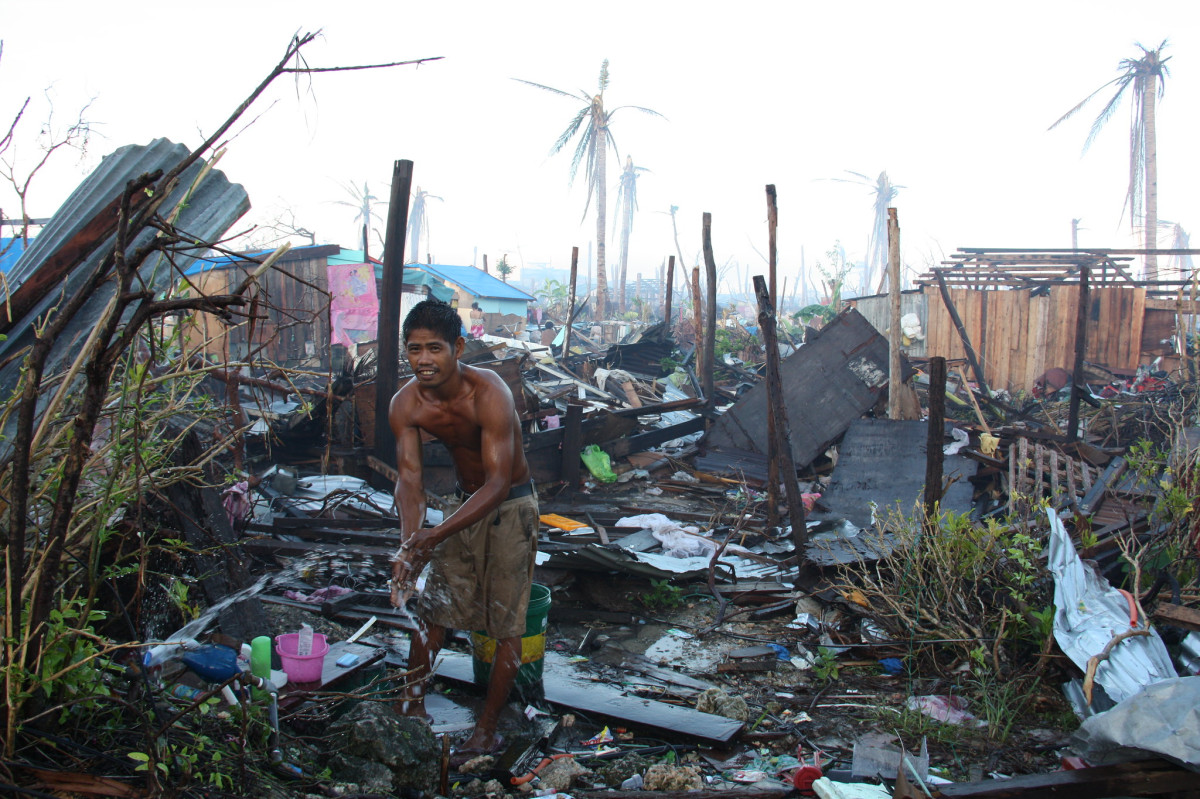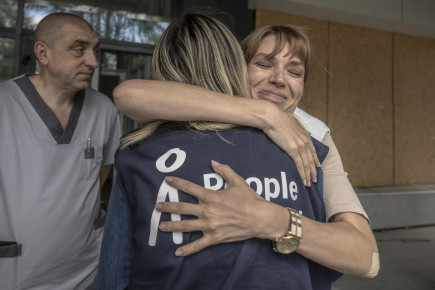Revisiting Typhoon Yolanda seven years later
Published: Dec 4, 2020 Reading time: 9 minutes Share: Share an articleSeven years have passed since Typhoon Haiyan, known locally as Super Typhoon Yolanda, made landfall in the Philippines. For the people of Guiuan, Eastern Samar, Yolanda serves as a benchmark whenever there is news of an impending storm, as Yolanda was one of the most powerful tropical cyclones ever recorded. Eastern Samar was the first to feel the wrath of the winds, lying directly in its path of destruction.

Even for an area prone to turbulent weather, this was no ordinary storm. To this day, farmers in Eastern Samar can still recall the events of November 8, 2013 as if they happened yesterday. These are the stories of four farmers and People in Need (PIN) beneficiaries who survived the tragedy.
The aftermath
Maria Casaroman, mother of 11 children and a farmer from the town of Santa Rosa, Balangiga, spent the duration of Yolanda in an evacuation centre. After the storm passed, she returned to her village and was shocked to find that her house had been reduced to a single column and a septic tank. The fish farm in her town had been completely swept away. And every coconut tree that had been planted had been knocked down by the storm.
Before Yolanda hit, Angeles Abayan, 57, was a copra producer and sweet potato planter. Upon news that a super typhoon was coming, she evacuated her home and stayed in a sturdier building nearby. Like the rest of Eastern Samar, she returned to a home that had been completely washed away by the turbulent waves.
Fermin Princillo was a village leader and a coconut farmer, but since the typhoon, he has been getting by with side jobs. "For a time I was fishing, then I went into the farming of root crops. I would take the motorcycle to the mountains to plant, or I’d weave nets by the sea," says Princillo.
A long way from home
Elmer Geven's story is a little different from other farmers who were in Eastern Samar during the storm. That day in 2013, he was working abroad as a blacksmith in Alberta, Canada. Before Yolanda made landfall, he had no idea that the storm would evolve into a super typhoon. His wife was still in Guiuan, while his kids were working near the country's capital in the city of Parañaque. The day after the storm, Geven learned from his boss that his hometown had been badly hit. He immediately packed up his belongings and tried to make his way home.
It took Geven 10 days to get to his family. Flights were difficult to book, and he was stranded in Bicol for four days. He finally arrived at the airport in Guiuan at around two in the morning, and then walked the final 10 kilometres because there was no other means of transportation.
The sight that greeted him was devastating. "All that was left of my home were some concrete blocks. My wife and brother-in-law were using palm tree leaves as a makeshift roof," Geven recalls. He had brought rice, canned goods, and a tarpaulin to replace their “roof.” He advised his kids not to return to the province, while he helped his wife rebuild.
The difficult road to recovery
Despite the seven years that have passed since Yolanda, Princillo cannot say with confidence that he has recovered from the effects of the typhoon. "I don't think it’s good to recall what happened because Yolanda was such a difficult time for us,” he says. “We lost our livelihood. Everything that we had planted was destroyed."
Since the catastrophe, Casaroman is not as afraid of strong winds because she feels that she has already survived the worst. "Now during storms, I go under the table so that if there is debris or hollow blocks or wood flying around, I am protected," she says.
Casaroman has also learned that when she hears of an impending storm, she must buy supplies early, prepare and waterproof all important documents, cut banana leaves so that the trees don't fall down as easily, and store harvested rice in a higher area so it does not get swept away. “Thanks to my training with People in Need, I know that it is possible to get insurance for my products from the Philippine Crop Insurance Corporation, ensuring that I still have a source of income if my plants are destroyed," she adds. Since 2013, Casaroman has also bought a boat, which she secures on higher land to ensure it will not get carried away by strong tides.
Venturing into cacao
Today, Geven is one of the beneficiaries receiving support thanks to a project funded by the New Zealand Ministry of Foreign Affairs & Trade Aid Programme and implemented by PIN and SPS Biosecurity Ltd. The project aims to increase the resilience for poor farmers through enhanced cacao production in Eastern Samar. Geven notes that he is grateful to PIN for the cacao seedlings he received. Despite being a cacao farmer for only a year, he believes that his life will change once he starts selling his crops.
Abayan, another beneficiary of the Eastern Samar program, also received training in cacao farming from PIN. She learned how to prune crops as well as how to provide fertile soil for her cacao plants. She believes that farming skills are essential to making a better living.
Abayan has yet to reap the rewards of her cacao crops, however, as many of them have not yet borne fruit. This is largely due to the effects of Typhoon Ursula, a strong storm that hit Eastern Samar in December 2019, washing away many of her existing crops.
Pandemic woes
The COVID-19 pandemic has brought even more difficulties for the people of Eastern Samar. Princillo, for instance, has had a hard time accessing the farm with his cocoa crops without a quarantine pass to negotiate restrictions on movement.
Still, he perseveres as best he can, hoping that the effort will reap rewards for his five children. "There is hardly a market for coconut anymore, so I have a lot of hope in this cacao programme."
Abayan shares Princillo’s sentiments. At the beginning of the lockdown, her husband was diagnosed with high blood pressure and heart problems. “He had to go to the hospital and I was the only one left working,” she says. Today, it is quite difficult for them to sell their bananas and vegetables, due to travel restrictions. “I can’t go far, and now I work on planting in the mountains just to make an extra living,” Abayan says. Now that her husband is slowly recovering, the couple farms together to make ends meet.
A problem of politics
The country’s political issues have weakened the people's trust that the government will help them. "If you are not well-connected with people from the local government unit, you are not likely to get much help from them," says Casaroman. There is also a lack of communication, as well as a shortage of initiatives that truly take the needs of the people into account. "There was a time when farmers were given boats and fishermen were given fertilizer. We were also given equipment for corn farming, even if what we know is rice farming," Casaroman adds. Instances like this make her feel that at the end of the day, people can only truly depend on themselves. Given the chance to speak to the people in power, she would ask for help with fertilizers and pesticide, as these are quite expensive, though necessary for maintaining her rice crops.
“Farmers should be given more importance,” says Abayan, adding: “I wish the government provided us with more assistance and training.” Princillo echoes a sentiment familiar to many of the farmers: leaders need to be more aware of the needs of their constituents. "They need to go beyond the four walls of their offices, look around, and see the state of the people, especially now that we are in the middle of a pandemic," he says.
A call to action
On top of these challenges there is also the matter of climate change, which affects farming practices perhaps more than any other issue. Casaroman notes: "The environment has to be protected. When illegal loggers cut trees, and people take away sand and gravel from the river, it becomes wider and deeper, and leads to more frequent flooding."
Princillo also believes that it is essential to act now to protect the environment. "You can prevent these calamities if you just plant a lot of trees and lessen pollution,” he says. “And do not burn your waste because the nutrients of the soil die, and the smoke produces pollution that our environment doesn't need."
In retrospect
When asked whether or not Eastern Samar had recovered from Super Typhoon Yolanda, the farmers had varying answers. Casaroman says that approximately 70 percent of the people in her area have recovered. As for those left behind, she believes it is because they did not use what was given to them in the proper way.
Princillo believes there is still a long way to go before the people of Eastern Samar can look forward to a sustainable future. Asked to name one thing that would help make a difference, he said that it would be a road linking the farm to the market. "We have to travel such a long distance, and even cross a river to get from the farm to the market. If we had a road, more people would plant cacao."
Princillo’s dream is that if he continues with cacao farming, his family’s future will be brighter. "I believe that this will help my family live, because when these crops grow, I will be able to invest the fruits of my labour."
Abayan shares Princillo’s hopes that cacao production will be successful in Eastern Samar. “Just take care of what you are planting,” she advises. “One day, it will all be worth it.”
Geven understands the importance of determination. "A lot has changed, but we cannot just depend on what the government gives us," he notes, stressing that for farmers, the success of creating a sustainable source of income depends on their level of commitment to the job. "We have to work for it. Farming is like raising a family. If you don't invest, nothing will come out of it."



